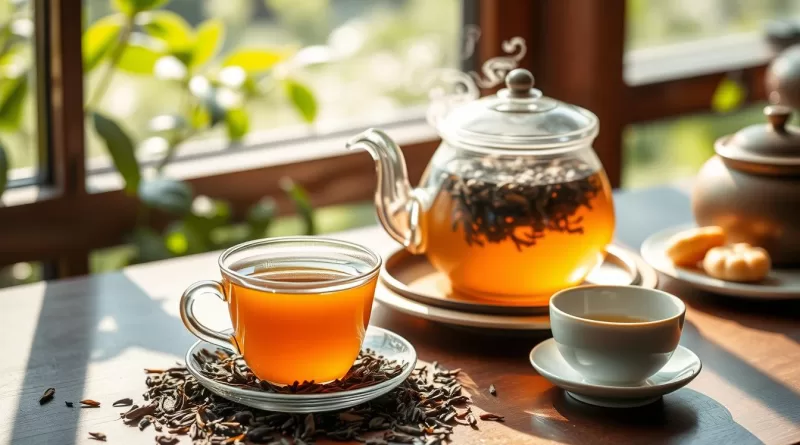Unlock the Secrets of Oolong Tea: Simple Recipe Included
Ready to try oolong tea? It’s a partially fermented tea with a unique taste. You can make it easily with a simple recipe. This guide will help you brew the perfect cup, whether you’re new or experienced.
Learning to make oolong tea is all about finding the right flavor. You can try different recipes to find your favorite. For more ideas, check out oolong tea recipe resources online.
This guide will help you become a pro at brewing oolong tea. You’ll learn from the basics to advanced techniques. So, let’s start and explore the world of oolong tea together.
Understanding Oolong Tea: A Perfect Balance of Flavor
Oolong tea is a unique and complex beverage. It offers a wide range of flavors and aromas. When you brew a cup, you get a perfect balance of flavor. This is thanks to a partial fermentation process.
This process makes oolong tea different from other teas. It gives a unique taste that is both refreshing and soothing.
One of the key oolong tea benefits is its ability to provide a sense of relaxation and calmness. The partial fermentation process involved in oolong tea preparation helps to create a smooth and silky texture. Whether you prefer homemade oolong tea or store-bought varieties, you can enjoy the numerous health benefits and flavor profiles that oolong tea has to offer.
What Makes Oolong Tea Unique
Oolong tea is made from the leaves of the Camellia sinensis plant. This is the same plant used to make black and green tea. However, the processing method is different, which gives oolong tea its distinct flavor and aroma.
The leaves are partially fermented. This helps to create a complex flavor profile that is both floral and fruity.
Different Types of Oolong Tea
There are several types of oolong tea, each with its own unique characteristics and flavor profiles. Some of the most popular types include:
- Tieguanyin: a partially fermented oolong tea with a complex flavor profile
- Wuyi Oolong: a type of oolong tea that is known for its smooth and silky texture
- Dongfang Meiren: a type of oolong tea that is known for its fruity and floral flavor profile
The Art of Oxidation
The art of oxidation is a crucial step in the production of oolong tea. The leaves are partially fermented. This helps to create a complex flavor profile that is both refreshing and soothing.
The level of oxidation can vary depending on the type of oolong tea being produced. This helps to create a unique flavor profile that is both delicate and complex.
Essential Equipment for Brewing Oolong Tea
To brew oolong tea, you’ll need the right oolong tea equipment. This includes a teapot, a tea strainer, and high-quality tea leaves. The teapot should be made of a material that keeps heat well, like ceramic or glass. A tea strainer is key for loose-leaf tea, letting the leaves unfurl and release their flavors.
Investing in a good oolong tea brewing guide will improve your oolong tea experience. It ensures each cup is perfectly brewed. The right equipment is crucial for following oolong tea steeping instructions. Here are some essential pieces:
- Teapot: Choose a teapot made from a heat-retentive material, such as ceramic or glass.
- Tea strainer: A tea strainer is essential for loose-leaf tea, allowing the leaves to unfurl and release their flavors.
- Tea leaves: High-quality tea leaves are essential for a great cup of oolong tea.
By investing in the right oolong tea equipment and following proper 
| Equipment | Description |
|---|---|
| Teapot | Made from heat-retentive material, such as ceramic or glass |
| Tea strainer | Allows loose-leaf tea to unfurl and release flavors |
| Tea leaves | High-quality leaves essential for a great cup of oolong tea |
Selecting the Perfect Oolong Tea Leaves
Choosing the right oolong tea leaves is key to a great brew. You can pick between loose-leaf tea and tea bags. Loose-leaf tea lets you adjust brewing and tastes more complex. For a oolong tea recipe for weight loss, loose-leaf is usually the better choice.
Here are some tips for picking the best oolong tea leaves:
- Origin: Choose leaves from well-known tea gardens or regions famous for oolong tea.
- Aroma: Fresh leaves should smell floral and distinct.
- Appearance: Quality leaves are evenly colored and have a uniform texture.
Quality Indicators to Look For
Check for tips or young leaves, which are tender and taste better. Also, look for Fair Trade or Organic certifications. These show the tea is sustainably made and meets quality standards.
For a real authentic oolong tea recipe, go for leaves from trusted brands. Many brands offer oolong tea, including oolong tea drink recipe blends for home brewing.
The Ultimate Oolong Tea Recipe
To make the perfect oolong tea, you need to follow a special recipe. It involves paying close attention to water temperature, tea amount, and steeping time. This recipe will help you make a unique and tasty oolong tea.
The water temperature should be between 180°F and 200°F. This depends on the oolong tea type you’re using. The tea-to-water ratio is usually 1 teaspoon of loose-leaf tea for every 8 oz of water. Here are some important guidelines:
Water Temperature Guidelines
- 180°F – 190°F for lighter oolong teas
- 190°F – 200°F for darker oolong teas
Tea-to-Water Ratio
The standard ratio is 1 teaspoon of loose-leaf tea per 8 oz of water. But you can adjust it to your liking.
Steeping Time Instructions
Steeping times vary, but start with 3-5 minutes for the first infusion. Adjust the time based on your taste preferences for strength and flavor.
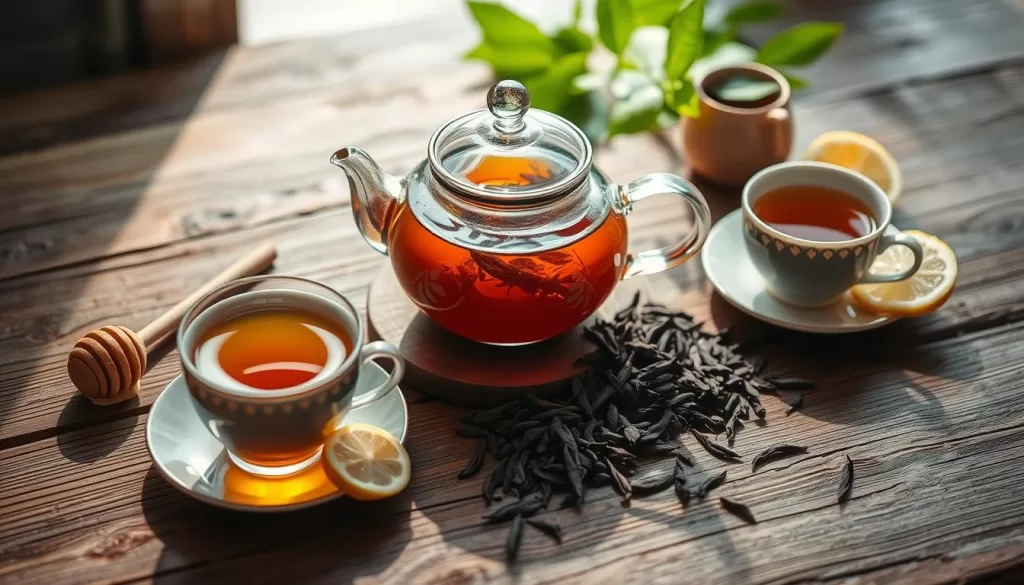
By following these steps and using a traditional recipe, you can make a delicious oolong tea. Remember to try different steeping times and tea amounts to find your favorite cup.
Advanced Brewing Techniques
Exploring oolong tea can lead to mastering brewing. Adjusting brewing parameters for different teas is key. For instance, some oolong teas need hotter water, while others prefer cooler. You can find oolong tea brewing tips online to help you.
Trying different water sources is another advanced technique. Using filtered or spring water can enhance flavors and aromas. Adjusting brewing times can also improve your tea’s taste. These healthy oolong tea recipes can boost your tea experience and support oolong tea weight loss.
Some advanced techniques include:
- Using a gaiwan or yixing teapot to brew your oolong tea
- Experimenting with different tea-to-water ratios
- Trying out different steeping times and temperatures
Mastering these techniques can unlock your oolong tea’s full potential. Enjoying a more nuanced and flavorful cup is possible. Whether for health or tea appreciation, these oolong tea brewing tips can help you reach your goals.
Multiple Infusions: Getting the Most from Your Leaves
Oolong tea is special because you can infuse it many times. Each time, you get a different taste. The first time is the strongest, and later infusions are more subtle. To enjoy your oolong tea fully, learn how to adjust your brewing for each infusion. For more tips, check out artfultea.com.
Try new oolong tea smoothie recipe ideas to make tasty drinks. Mix your oolong tea with fruits and herbs for a refreshing drink. For more ideas, visit jugosnaturales.net.
Choosing a best oolong tea brand is key to enjoying its full flavor. A good brand lets you enjoy oolong tea’s benefits, like weight loss and better digestion. Learn more in oolong tea benefits recipe guides.
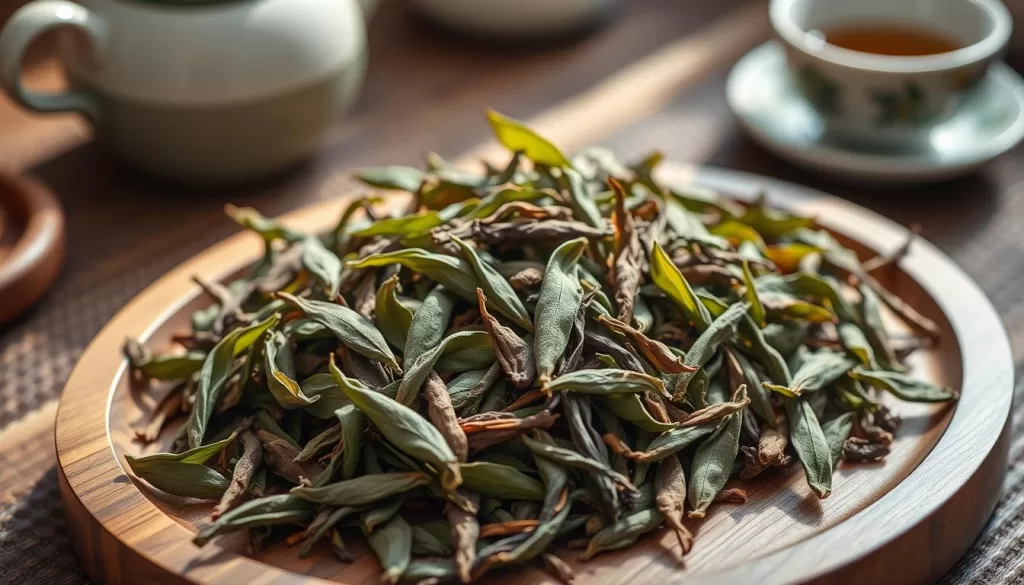
First Infusion Process
The first infusion is crucial. It sets the flavor for the rest. Use the right water temperature and steeping time for the best taste.
Subsequent Steeping Methods
For later infusions, adjust the steeping time and water temperature. This brings out different flavors. Try different methods to find your favorite.
Flavor Evolution Guide
As you infuse multiple times, the flavor changes. A flavor evolution guide helps you understand these changes. It lets you appreciate each infusion’s unique taste.
Common Mistakes to Avoid When Brewing Oolong
When brewing oolong tea, there are a few common mistakes to watch out for. One big error is using water that’s too hot. This can burn the tea leaves and make the tea taste bitter. Another mistake is steeping the tea for too long. This can make the tea taste bad because it extracts too many tannins.
To avoid these mistakes, it’s key to use high-quality water. Also, adjust the brewing time and temperature for each infusion. This ensures your oolong tea tastes great every time.
Other common mistakes include:
- Not using loose-leaf tea, which can result in a less flavorful cup
- Adding too many ingredients, which can overpower the delicate taste of the tea
- Not adjusting the oolong tea steeping time and temperature for different types of oolong tea
For more tips on avoiding common tea brewing mistakes, check out this website. Experts share their knowledge to help you brew the perfect cup of oolong tea every time.
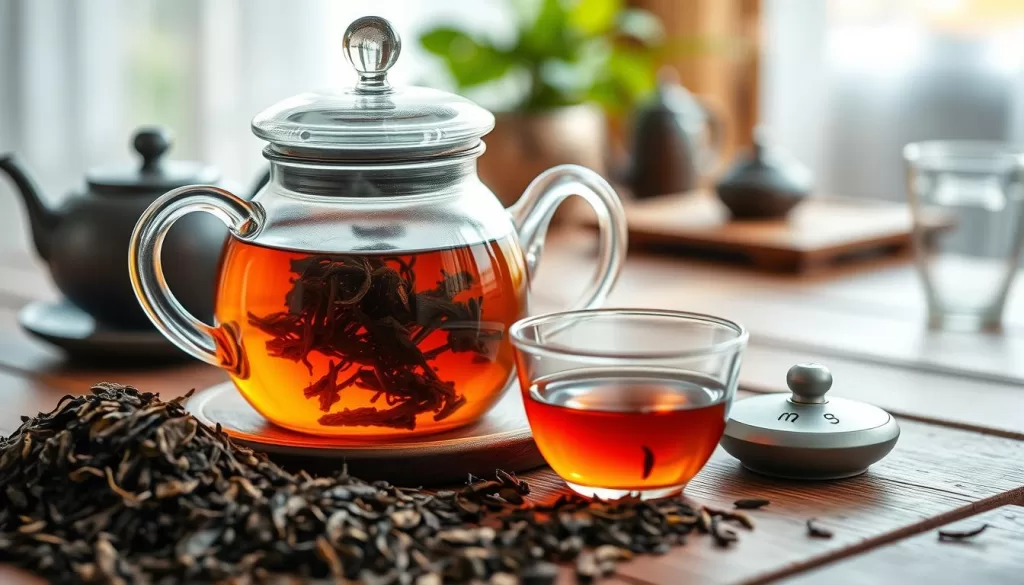
Health Benefits and Best Times to Enjoy
Oolong tea is a tasty and healthy drink with many oolong tea benefits. It helps with weight loss and digestion. Adding it to your daily routine can boost your metabolism and health.
Some of the key oolong tea health benefits include:
- Increased metabolism, which can aid in oolong tea for weight loss
- Improved digestion, reducing the risk of certain diseases
- Antioxidant properties, which can help protect against cell damage
To get the most out of oolong tea benefits, know when to drink it. You can enjoy oolong tea any time. But it’s best to drink it:
- In the morning, to boost your metabolism and energy levels
- After meals, to aid in digestion and reduce the risk of certain diseases
- In the evening, to relax and unwind after a long day
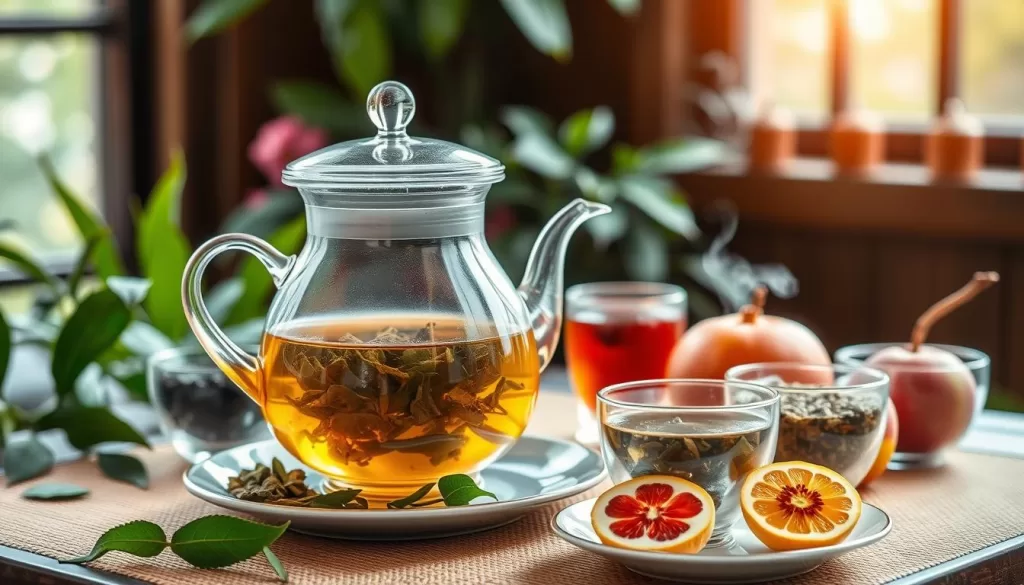
Adding oolong tea to your daily routine can improve your health. It’s great for weight loss, digestion, or just a healthy drink. Oolong tea is a smart choice.
Conclusion: Mastering Your Oolong Tea Journey
Starting your oolong tea journey is exciting. It’s about patience, practice, and exploring. This guide has given you the basics to make great oolong tea.
Keep exploring oolong tea and enjoy the journey. It’s as rewarding as reaching your goal. Try new flavors and find your favorite oolong tea. With each sip, you’ll discover more and enjoy its true taste.
So, enjoy your oolong tea and make it a special part of your life. May your journey be filled with joy, discovery, and a love for this amazing tea.

